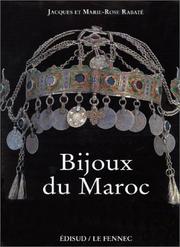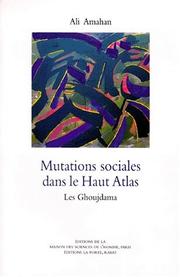| Listing 1 - 10 of 31 | << page >> |
Sort by
|
Book
ISBN: 2010077806 Year: 1981 Publisher: [Paris] : Hachette Réalités,
Abstract | Keywords | Export | Availability | Bookmark
 Loading...
Loading...Choose an application
- Reference Manager
- EndNote
- RefWorks (Direct export to RefWorks)
Book
ISBN: 2855880068 9782855880068 Year: 1980 Publisher: Toulouse: Éd. des Hespérides,
Abstract | Keywords | Export | Availability | Bookmark
 Loading...
Loading...Choose an application
- Reference Manager
- EndNote
- RefWorks (Direct export to RefWorks)
Berbers --- #GOSA:II.P.AU.1 --- Amazigh --- Imazighan --- Imazighen --- Mazigh --- North Africans --- Berbers.
Book
ISBN: 0715606395 Year: 1973 Publisher: London : Duckworth,
Abstract | Keywords | Export | Availability | Bookmark
 Loading...
Loading...Choose an application
- Reference Manager
- EndNote
- RefWorks (Direct export to RefWorks)
Berbers --- Amazigh --- Imazighan --- Imazighen --- Mazigh --- North Africans --- Algeria --- Morocco --- Politics and government. --- Sociology of minorities --- Berbers.

ISBN: 2857448643 9782857448648 Publisher: Edisud / Le Fennec
Abstract | Keywords | Export | Availability | Bookmark
 Loading...
Loading...Choose an application
- Reference Manager
- EndNote
- RefWorks (Direct export to RefWorks)
Berbers --- Ethnic jewelry --- Jewelry --- Amazigh --- Imazighan --- Imazighen --- Mazigh --- North Africans --- Applied arts. Arts and crafts --- Morocco
Book
ISBN: 1283004348 9786613004345 1441119361 9781441119360 9781441101273 1441101276 144117933X 9781283004343 Year: 2011 Publisher: London New York Continuum International Pub. Group
Abstract | Keywords | Export | Availability | Bookmark
 Loading...
Loading...Choose an application
- Reference Manager
- EndNote
- RefWorks (Direct export to RefWorks)
This book presents a study of various important aspects of Tamazight Berber syntax within the generative tradition. Work on Berber linguistics from a generative perspective remains in many ways uncharted territory. There has been hardly any published research on this language and its different dialects, especially in English -- this book fills some of these gaps and lays down the foundations for further research. Ouali looks at three seemingly disparate ranges of syntactic phenomena, namely Subject-verb agreement, Clitic-doubling and Negative Concord. These phenomena have received different
Berbers --- Tamazight language --- Berber languages --- Grammar. --- Grammar --- Amazigh --- Imazighan --- Imazighen --- Mazigh --- North Africans
Periodical
ISSN: 27284395 Year: 1986 Publisher: [Paris] : La Boîte à documents,
Abstract | Keywords | Export | Availability | Bookmark
 Loading...
Loading...Choose an application
- Reference Manager
- EndNote
- RefWorks (Direct export to RefWorks)
Présentation La revue "Etudes et Documents Berbères" est éditée par La Boîte à Documents, est ouverte à la communication scientifique, berbérisante ou non et est placée sous l'égide de la Maison des Sciences de l'Homme Paris Nord. Cette page dédiée à la revue Études et Documents Berbères va se développer au cours des années 2022 et 2023. À l’origine, c’est grâce au soutien du Centre national du Livre (CNL) que les volumes 27 à 42 correspondant aux années 2008 à 2019 ont pu trouver leur place sur cette plateforme. Outre la mise en place des résumés pour tous les articles de la revue ainsi que leur traduction, un travail de rétroconversion des fichiers et leur mise en ligne sont envisagés.
Berbers --- Berbers. --- Berbertalen. --- Amazigh --- Imazighan --- Imazighen --- Mazigh --- North Africans --- Berber languages --- Langues berbères --- Berbères --- Periodicals. --- Périodiques. --- Libyan languages --- Afroasiatic languages --- Berber languages.
Book
ISBN: 0812296184 081225130X 0812225244 Year: 2019 Publisher: University of Pennsylvania Press
Abstract | Keywords | Export | Availability | Bookmark
 Loading...
Loading...Choose an application
- Reference Manager
- EndNote
- RefWorks (Direct export to RefWorks)
Before the Arabs conquered northwest Africa in the seventh century, Ramzi Rouighi asserts, there were no Berbers. There were Moors (Mauri), Mauretanians, Africans, and many tribes and tribal federations such as the Leuathae or Musulami; and before the Arabs, no one thought that these groups shared a common ancestry, culture, or language. Certainly, there were groups considered barbarians by the Romans, but "Barbarian," or its cognate, "Berber" was not an ethnonym, nor was it exclusive to North Africa. Yet today, it is common to see studies of the Christianization or Romanization of the Berbers, or of their resistance to foreign conquerors like the Carthaginians, Vandals, or Arabs. Archaeologists and linguists routinely describe proto-Berber groups and languages in even more ancient times, while biologists look for Berber DNA markers that go back thousands of years. Taking the pervasiveness of such anachronisms as a point of departure, Inventing the Berbers examines the emergence of the Berbers as a distinct category in early Arabic texts and probes the ways in which later Arabic sources, shaped by contemporary events, imagined the Berbers as a people and the Maghrib as their home.Key both to Rouighi's understanding of the medieval phenomenon of the "berberization" of North Africa and its reverberations in the modern world is the Kitāb al-'ibar of Ibn Khaldūn (d. 1406), the third book of which purports to provide the history of the Berbers and the dynasties that ruled in the Maghrib. As translated into French in 1858, Rouighi argues, the book served to establish a racialized conception of Berber indigenousness for the French colonial powers who erected a fundamental opposition between the two groups thought to constitute the native populations of North Africa, Arabs and Berbers. Inventing the Berbers thus demonstrates the ways in which the nineteenth-century interpretation of a medieval text has not only served as the basis for modern historical scholarship but also has had an effect on colonial and postcolonial policies and communal identities throughout Europe and North Africa.
Berbers --- Amazigh --- Imazighan --- Imazighen --- Mazigh --- North Africans --- Historiography. --- History --- History. --- African Studies. --- Asian Studies. --- European History. --- Medieval and Renaissance Studies. --- Middle Eastern Studies. --- World History. --- Africa, North

ISBN: 2735119564 2735107698 9981889210 Year: 2016 Volume: 2 Publisher: Paris : Éditions de la Maison des sciences de l’homme,
Abstract | Keywords | Export | Availability | Bookmark
 Loading...
Loading...Choose an application
- Reference Manager
- EndNote
- RefWorks (Direct export to RefWorks)
Les Ghoujdama, tribu du Haut Atlas, par leur ancrage dans l'histoire et leur capacité d'adaptation au monde moderne constituent un cas exemplaire pour comprendre le Maroc et par-delà le monde rural maghrébin. Par une étude historique solide, l'auteur nous montre les Ghoujdama à l'aube du xxe siècle, sous la double domination du Glaoui et du Protectorat et depuis l'indépendance. Grâce à la connaissance intime de ce milieu dont il est issu, ALI AMAHAN, dans le sillage de Robert Montagne, Jacques Berque, Paul Pascon, Pierre Bourdieu, aborde avec acuité, justesse et authenticité l'analyse des mutations sociales chez les Ghoujdama. Il révèle les mécanismes enfouis dans les structures sociales et mentales, dévoile la dynamique spécifique qui incite au changement mais aussi à la résistance, et montre que la confrontation entre changement et permanence n'est en fait que la juxtaposition de deux systèmes, l'un moderne et puissant, l'autre traditionnel et ancestral. Ces systèmes se complètent et ne s'opposent que rarement ; ils s'appuient mutuellement l'un sur l'autre pour perdurer et évoluer.
Berbers --- Berbères --- Social conditions --- Social life and customs --- Conditions sociales --- Moeurs et coutumes --- High Atlas Mountains (Morocco) --- Haut Atlas (Maroc) --- Social conditions. --- Amazigh --- Imazighan --- Imazighen --- Mazigh --- North Africans --- Ghoujdama --- Haut-Atlas --- Berbère --- XXème siècle --- tribu --- Maroc --- coutumes
Book
ISBN: 2903442320 Year: 1987 Publisher: Paris Errance
Abstract | Keywords | Export | Availability | Bookmark
 Loading...
Loading...Choose an application
- Reference Manager
- EndNote
- RefWorks (Direct export to RefWorks)
308 <=933> --- Berbers --- 961 --- 391 <=1.61> --- 908 <=933> --- Amazigh --- Imazighan --- Imazighen --- Mazigh --- North Africans --- Africa, North --- -Barbary States --- Maghreb --- Maghrib --- North Africa --- Social life and customs --- Berbers. --- Social life and customs. --- -Social life and customs
Book
ISBN: 9954439137 Year: 2004 Volume: 8 Publisher: Rabat Institut Royal de la Culture Amazighe
Abstract | Keywords | Export | Availability | Bookmark
 Loading...
Loading...Choose an application
- Reference Manager
- EndNote
- RefWorks (Direct export to RefWorks)
Berber --- Berbers --- Berbères --- #KVHA:Geschiedenis; Arabische volken --- #KVHA:Geschiedenis; Berbers --- Berbères --- History of Africa --- History --- Social life and customs --- Histoire --- Moeurs et coutumes --- Africa, North --- Afrique du nord --- Amazigh --- Imazighan --- Imazighen --- Mazigh --- North Africans --- Morocco --- History.
| Listing 1 - 10 of 31 | << page >> |
Sort by
|

 Search
Search Feedback
Feedback About UniCat
About UniCat  Help
Help News
News